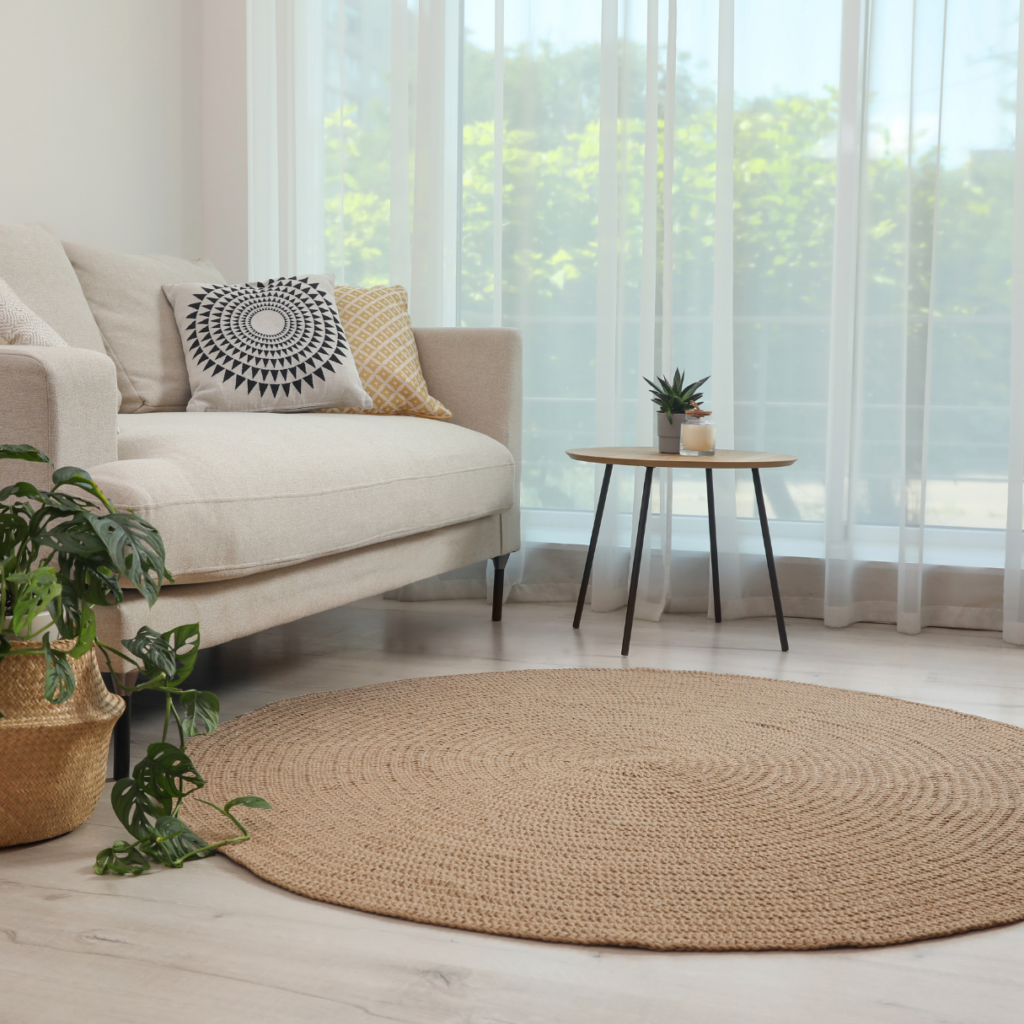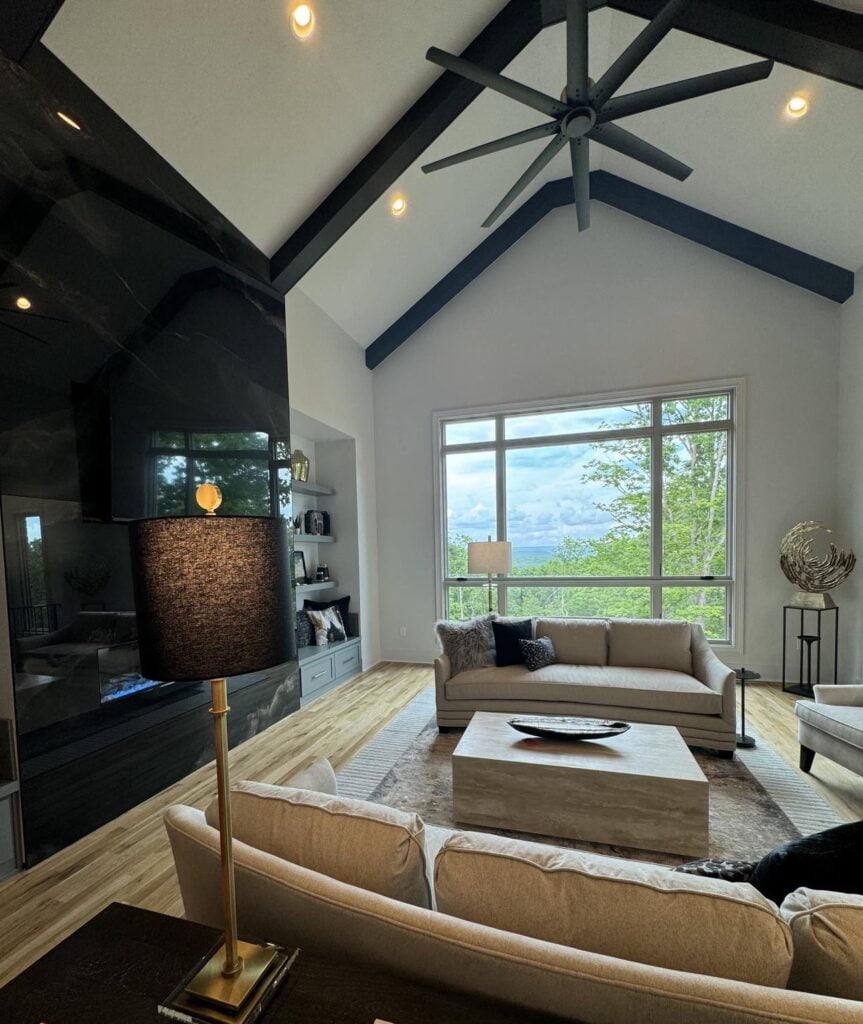Your living room is more than just a room; it’s the heart of your home, and it’s where you create memories with family and entertain friends. For me, it’s always been a place to relax, unwind, and truly enjoy the company of those I care about.When I was looking for inspiration to know how to decorate a living room, I’ve found that making the space feel inviting and cozy is the key.
Whether it’s the comfort of a living room couch or the elegance of a modern living room with a TV and a lamp, I love how every little detail can change the atmosphere of a room.
In this article, I’m excited to share some of my favorite interior design ideas for living rooms along with all tips and tricks that I’ve learned to create a space that’s both stylish and functional.

10 Tips on Cozy and Welcoming Decor For Living Room
Start with a Plan
I’ve learned the hard way that decorating without a plan is a recipe for disaster. I once fell in love with a fancy living room chair, only to realize it clashed horribly with everything else in the room. Trust me, taking a little time upfront to map things out will save you so much frustration later.
First, think about how you want to use the space. Is it going to be a cozy spot for family movie nights, a place to host friends, or maybe a mix of both? Once you’ve nailed that down, grab a notebook and sketch a rough layout. I like to use painter’s tape on the floor to outline where my modern living room couch or coffee table will go. Believe me, it’s a game-changer!
But, something you can’t overlook: measure everything. Seriously, I’ve seen people struggle to fit a luxury living room sofa through a door, and it’s not pretty. I also like to use painter’s tape to outline furniture spots on the floor. It helps me see if the arrangement works before committing.
Another trick I swear by is picking a color palette upfront. Choose two or three main colors for walls, furniture, and decor. This keeps the room looking pulled together. If you’re unsure, check out color schemes online for inspiration.
Starting with a plan might take a little extra time, but it’ll save you headaches and make decorating way more fun!
Choose a Focal Point
Every living room needs that “wow” factor; a focal point that immediately draws attention. For me, this has been everything from a statement fireplace to a modern living room with a TV and a lamp setup that’s perfectly cozy.
Your focal point can be anything: a bold piece of art, a large window with a view, or even a fancy living room chandelier. Once you’ve decided, arrange your furniture and decor for living room to highlight it. For instance, I love pairing my focal point with subtle touches, like a cozy throw on the couch or some greenery nearby.
Here’s a tip: stick to one main focal point. As Malka Helft, founder of Think Chic Interiors said “Create a focal point by arranging the room so everyone’s eyes are going to go a beautiful piece of art“. So, how to decorate a living room with just a focal point then? Practically, If you have a fireplace and a TV(let’s be real, for many of us, it’s the TV), pick one to emphasize. Moreover, you can make the fireplace stand out with a large mirror or artwork above it, while keeping the TV setup clean and simple.
Lighting is another thing that can make or break the look of your living room. Use a lamp or spotlight to draw attention to your focal point, especially if it’s a piece of art or a gallery wall.
And don’t be afraid to add some personality. If your focal point is a shelf, style it with a mix of books, plants, and personal items. The idea is to make the space feel intentional and inviting.
Create Comfortable Seating Arrangements
Seating is one of the most important parts involved in the mystery of how to decorate a living room for me. It’s where I spend most of my time, whether I’m enjoying a cozy evening alone or hosting friends and family.
Comfort and flow are my priorities, so I always arrange the seating in a way that encourages easy conversation and keeps everyone feeling relaxed. Attempt to create conversation areas by grouping seating to naturally foster interaction.
For instance, set up a modern living room couch facing two armchairs with a coffee table in the middle. This setup is ideal for group chats or even family game nights.
I also value flexibility, so I make sure to include versatile seating options like poufs or ottomans that can be moved around as needed. Another key consideration for me is distance. Another important thing is to ensure that seating isn’t too far apart so people can comfortably engage in conversations without needing to raise their voices.
Keeping the average living room size in mind is essential to maintaining balance and flow within the space. This thoughtful arrangement makes the idea of how to decorate a living room both functional and inviting.
Use Rugs to Define Spaces

Rugs have the power to completely transform the vibe of a living room, and I’ve seen how they can define different areas. It works especially in open-plan spaces or living rooms that form the front perspective of a home. They’re a key element in creating a cozy, welcoming atmosphere that ties the entire space together.
For me, size matters when choosing a rug. I always make sure it’s large enough to anchor the seating area. It works best ideally with all major furniture pieces placed on it.
I also love layering rugs to add texture and visual interest. I mean it actually makes you feel royal! Pairing a larger neutral rug with a smaller patterned one can enhance the overall design. Placement is equally important for achieving a cohesive look.
For instance, positioning the rug under a coffee table with the front legs of the surrounding seating on it creates a balanced and harmonious arrangement
Balance Lighting
Many people don’t give enough attention, but lighting plays a crucial role in setting the mood and functionality of a living room. Honestly, I hate whenever I am talking with someone and I can’t even see their face clearly because of poor lighting
Layered lighting is an effective strategy, combining ambient, task, and accent lighting. While ambient lighting ensures overall brightness, task lighting focuses on specific areas like reading nooks, and accent lighting highlights unique decorations or adds depth to the space.
Dimmer switches are a great addition, as they allow control over the light’s intensity to create different moods. I find them especially useful for transitioning from a bright, functional setting to a relaxed, cozy vibe in the evening.
Maximizing natural light is essential for any living room decor. A survey by Marvin Windows and Doors found that nearly 3 out of 5 homeowners value natural light and fresh air in their homes.
I like to keep windows free of heavy curtains and opt for sheer ones that diffuse sunlight beautifully, brightening the room while enhancing its warmth and charm.
How to decorate a living room using shelves and Other Storage Solutions
How to decorate a living room starts with understanding the space and its function. A well-organized living room is crucial for creating a relaxing and welcoming environment. Its importance was also highlighted by a Houzz survey showing that 56% of homeowners focused on improving comfort and functionality during living room renovations.
Incorporating smart storage solutions has transformed my space, making my living room decor both functional and visually appealing. Here’s my tips if you’re wondering how to decor a living room with storage?
Without a doubt, using built-in shelves should be a part of all living rooms. You can use them to display books, decorative items, and family photos adds character while keeping everything organized and easily accessible.
Opting for furniture pieces that double as storage, such as ottomans with hidden compartments or coffee tables with drawers, helps maximize space and reduce clutter.
Moreover, using decorative baskets and bins to store blankets, magazines, and toys not only keeps the space organized but also adds a stylish touch. They are practical and easy to move around, maintaining a neat appearance throughout the room.
Add Personal Touches
Personal touches are essential for making your living room feel warm and inviting. In beginning of this idea, I wondered How to decor a living room with my personal style while ensuring the living room is guest-friendly? Displaying artwork that reflects my taste and personality is a must. I enjoy mixing different styles and sizes for a curated and eclectic look that speaks to my individuality.
Incorporating family photos in stylish frames adds a personal touch. Whether creating a gallery wall or placing them on shelves and side tables, they bring warmth and memories into the room.
Including items with sentimental value, like travel souvenirs or heirlooms, adds a unique charm to my space. These pieces not only tell stories but also contribute to the cozy and welcoming atmosphere I strive for in my living room.
Use Color Wisely
Color can dramatically affect the mood of your living room. Emily Henderson, Stylist and Author, emphasized this factor, “Sticking to two or three primary colors creates a harmonious and elegant look, even in a bold or eclectic space.” You can choose a color palette that enhances the ambiance you want to create:
Starting with a neutral base for larger furniture pieces provides a versatile backdrop for other colors to pop against.
I also prefer adding pops of color through accessories like cushions, throws, and artwork that can give life to the space. It’s essential to choose colors that complement each other and the overall theme of your home.
Ensuring that the color scheme flows well with adjacent rooms helps maintain a cohesive look throughout your home. This approach ties the spaces together and enhances the overall aesthetic appeal.
Bring in Nature
One popular approach to how to decorate a living room is incorporating natural elements for a refreshing look. Adding natural elements is one of the simplest ways to elevate your living room decor while making it feel refreshing and alive.
As Nina Mogan, a Housten based interior designer, emphasized the importance of greenery while working for her client’s living room, “Greenery and florals were introduced into the space to accentuate the exterior landscaping, which in turn brought life and put the final touches on the space.”
I enjoy adding indoor plants to bring life and greenery indoors. Opting for low-maintenance varieties ensures they thrive even if you don’t have a green thumb.
Natural materials like wood, stone, and linen are staples in furniture and decor. They add warmth and texture, creating a cozy and inviting atmosphere.
Fresh flowers are always a must-have. Placing a vase of fresh flowers on a coffee table or side table not only adds a pop of color but also fills the room with a subtle fragrance that enhances the overall ambiance.
Focus on Comfort
Ultimately, an inviting living room should prioritise comfort. I love using soft textiles like cushions, throws, and rugs to make the space feel cosy. Layering different textures creates a warm and welcoming atmosphere that everyone enjoys.
Adding warmth is also important, whether through a fireplace or a space heater. A crackling fire, in particular, instantly makes the room feel inviting and relaxing.
Accessibility is something I always consider to keep the space functional. For example, having a side table near the sofa ensures essentials like drinks, books, or remote controls are always within easy reach.
Final Thoughts
Remember, the key to transforming your living room into a welcoming hub is to reflect your personality and meet your needs. Take your time to experiment with different interior design ideas for living room, and don’t be afraid to plan on how to decorate a living room. Once you find what works best for you, you’ll have a space that’s cozy, inviting, and uniquely yours. Start planning your design from today!
Suggested Articles
Where to buy living room furniture?
Finding the perfect living room furniture is easy when you know where to look
Local Furniture Stores: Explore stores like Harvey Norman or Freedom for premium options you can test in person.
Online Marketplaces: Websites like IKEA, Wayfair, Amazon, and Temple & Webster offer a wide range of styles and prices, often with free shipping or discounts.
Custom Furniture Shops: Tailored solutions for unique spaces, such as sectional sofas or bespoke coffee tables.
Thrift Stores or Marketplaces: Check platforms like Facebook Marketplace or thrift stores for budget-friendly or vintage finds.
Big-Box Retailers: Affordable and stylish furniture options from stores like Target or Walmart.
What color schemes work best for a welcoming living room?
Warm neutral palettes, such as beiges, creams, and soft grays, create a relaxed and inviting atmosphere. Incorporating textures and pops of color through accessories can add depth and interest without overwhelming the space.
What lighting options are best for creating a welcoming ambiance?
Layered lighting, including ambient, task, and accent lighting, allows for flexibility and sets a warm tone. Dimmable lights can adjust the mood as needed. Incorporate floor lamps, table lamps, and wall sconces to create a cozy and inviting environment.
By addressing these aspects, you can transform your living room into a space that is both personal and inviting, making guests feel comfortable and welcome.









